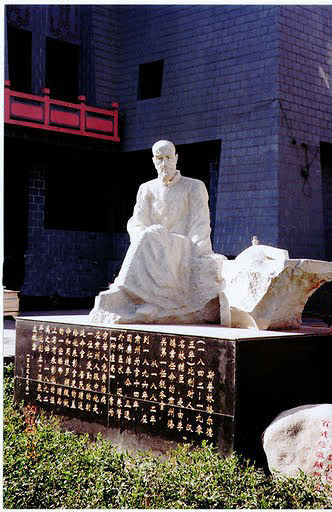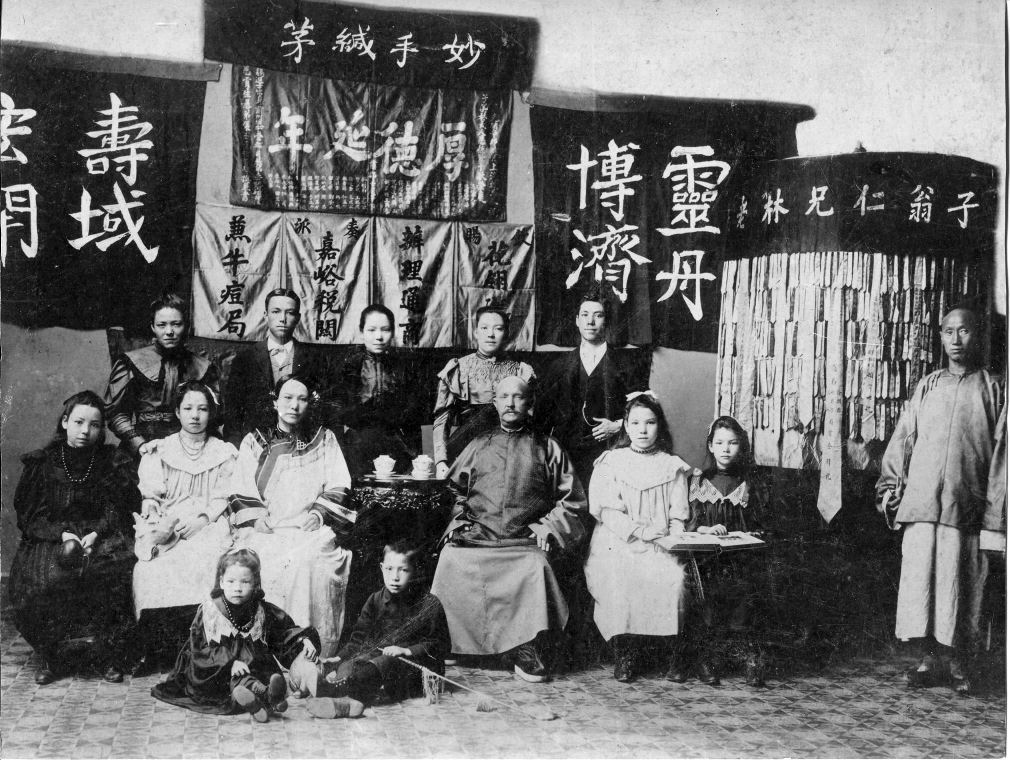


PAUL SPLINGAERD
biography
the belgian mandarin of the Qing's dynasty

La statue de Lin Fuchen à Jiuquan (Gansu)
 |
The great Eastern adventure of this family starts when a young Fleming of the area of Wavre (Belgium), recorded as being Paul SPLINGART (Splingard, Splingaerd), born on April 12, 1842 in Brussels of unknown father, given up by his poor mother born Pauline Splingart (Splaingard), in the turn of the Old people's home "beared of two bonnets, of a shirt, a cotton nightshirt and a encullot of fabric". Regarded as a "child of the Fatherland", he is entrusted successively to family DEPRE (Deprée) then with family VANDEPUT and passes her childhood in the Belgian village of Ottenburg-Huldenberg. He leaves for China, in 1865, as assistant of the chaplain, Theophilus VERBIST, whom he met at the end of his military service, and which has just founded the Congregation of the Missions of Scheut (period 1865-1868). The conversion of the Chinese is his objective. Vast program for which he sticks Paul Splingaerd like assistance-domestic. Two other missionaries join to them and, in August 1865, they embark for Tianjin, while passing by Marseilles and Rome where they are received in audience by the Pope.
|
|---|
Paul Splingaerd vers 1865 - (Photographie H. De Saedeleer, Bruxelles (from J. Spae)
 |
The foundation was named Congregatio Immaculati Cordis Mariae (CICM, which translates to the Congregation of the Immaculate Heart of Mary) with Fr. Verbist as superior. |
|
 |
It is with Theophilus Verbist of which he was the servant and with Ferdinand Hamer that Paul Splingaerd from went away towards glory, passing by Paris, Marseilles, etc.
|
 |

LIN FU CHEN
 |
Baron Paul Wilhelm Ferdinand Von Richthofen, (05/05/1833 - 06/10/1905) geographer and famous German geologist who was the owner of Paul Splingaerd during four years. In their writings, he did not tare praises for the services that Paul returned to him. He is more known general public for his invention of the term Silk Road (Route de la soie) to indicate the ways of transit of the trade Asia-Europe during many centuries.
|
 |
|
In spite of the distress of China where reign the famine, his marriage was happy, in spite of the financial difficulties due to his lack of commercial skill and his frequent absences from which his employees profited "to weigh down delivered wool, with sand".
In 1881, he is appointed Mandarin, officer of the Imperial Customs with SOU-TCHEOU (Suzhou - Gansu), by the large minister and viceroy LI-HUNG-TCHANG of which he became the right-hand man; it is a city close to Turkestan, at 2000 km of the East-coast, located at the north of the province of Gansu, vis-a-vis at the western part of the large desert of Gobi, on the old Silk Road. He will remain there more than 14 years.

Shanghai, 1896
Photo studio Sze-Yuen-Ming - Shanghaï - 1896
In 1896, he sent his 8 older girls (his daughter Susan, born in 1878 in Shanghai, he dies of cholera in 1895 and Maria was born and died in 1882) and her three boys in Shanghai by the Dames Auxiliatrices and the Marist Brothers, for we take care of their education more European as their first language was obviously Chinese. To be closer to his family (it took about three months to travel back to the coast), after more than fourteen years of duty, he found a job to advise the Kaiping coal mines near Tientsin.
In 1897, he is destined for Shanghai by colonel Fivé, to be used as interpreter between the authorities of Peking and the Belgian mission Dufourny-Wallin; and by obtaining facilities of his direction. He is used then as interpreter during the first negotiations between the Chinese government and the Belgian delegations for the construction of the railway line PEKING-HANKOW. This work was carried out by Jean Jadot in less than ten years and was an extraordinary success.
Three of her daughters entered the Congregation of Dames Auxiliatrices: they become Mother Saint Jerome, who will deal later manufacture embroidery SI-KA-WEI (died in China), Mother Santa Rosa (died in California) and mother Santa Clara teach literature in a European institute for young Chinese girls. The fourth was intended for the cloister, but seems to have subsequently joined the Dames Auxiliatrices (Anna - Mother St. Dosithee). The second and last took their retirement in the Paris area where they died. As boys, the oldest actor to be the Belgian legation in Peking, the second work as a commercial agent in Kaiping coal mines which had 5000 workers, the third will be studied at the Institut St-Boniface in Brussels. This boy, John Splingaerd, returned to China and, after an interesting career at the company CTET, died in 1948 after two marriages without children.
In 1900, it is the storm of the Boxers which sow dead and desolation in China. Paul takes part in the Belgian mission Fivé with his son Remy and fight against the Chinese gangsters. Named brigadier general (in a a little honorary way) by the government of Peking, Paul SPLINGAERD, provided with the legal full powerss, furrows Innerl Mongolia and that of the south-west which he know well, with like particular mission recovering, by threat or negotiation, girls removed by the Chinese gangsters. He effectively protects the members from the clergy against the exactions of the gangsters. Those owe him much and they recognize it. He became Commissioner of the Belgian Congo in China and Mandarin red button.
It should be stressed that the friendly relations that Splingaerd maintained through all the Celestial Empire rendered innumerable services as well in Scheutistes as to Belgium. The megalomaniac King and slavedriver Léopold II himself called upon him when it entered his vast projects to create Katanga in China, an idea which met the opposition of the foreign powers and the mistrust of the Chinese.
In 1901, the death of the viceroy Li deprives our compatriot of an ally and this death, occurring little after the revolt of the Boxers, makes it possible to obtain that "Belgian Mandarin sings a lower tone"... Splingaerd played, nevertheless, an important role, in 1902, in the negotiations aiming at compensating the foreign missions put at evil by the Boxers. These negotiations and these compensations, which were considered exaggerated later on later, had a fundamental influence in the relations which were established in Belgium and China during the time between the two wars, without counting the establishment of the Belgian concession of Tientsin.
Colonel Fivé, in addition, had proposed to king Léopold II to use Scheutistes within the framework of the colonization of Gansu. Splingaerd was to be used as interpreter to engineer Ledent and to the Lambert second lieutenant. It was a failure because of a bad preparation and differences in opinion between Ledent and Splingaerd, at least, it is that one says.

Le mandarin Paul Splingaerd en 1906
At the end of 1905, he persuades taotaï PENG of LANCHOW-FOU (Lanzhou) to use Belgian engineers and is missionné to go to Belgium in order to recruit some and to bring back some (for the factories of lacquer and sugar, organization and exploitation of the gold mines, search for sources of oil, grounds with beets in Gansu, etc). With this occasion, he tries to see the king Léopold II, but this last will refuse to receive it because of the not very pleasing reports of Fivé whose mission in Mongolia had been a fiasco. Income the same year in China with the specialists (who were not completely those hoped), he dies with SI-NGAN-FOU (XI'AN) on September 26, 1906, on the road of Gansu, probably of a coma diabetic.
His son Alphonse come to join it for his anguish will bring back the body of the General to Peking. And that which Mgr. Otto described as Belgian Marco Polo had his tomb close of those of Matteo Ricci and Ferdinand Verbiest (around the church of Chala, in Peking). His wife joined there in 1918. Its exact site is unknown today
The four girls of Paul and Catherine who do not enter in the religious congregations married four Belgian specialists, Jean-Jacques MULLER, Albert PATERNOSTER, Robert VAHRENKAMPF and Louis CASTAIGNE which returned gradually to Belgium with their families, before the arrival of the Japanese.
|
|
Now available, the book: THE BELGIAN MANDARIN written by Anne Splingaerd Megowan, downward direct of Lin Fuchen. A family treasure!
click here to know some more about the book and the author
|
|

![]()
Christian Goens - La Louvière - Belgium - 2003 - tous droits réservés
last update: 25-avr-19